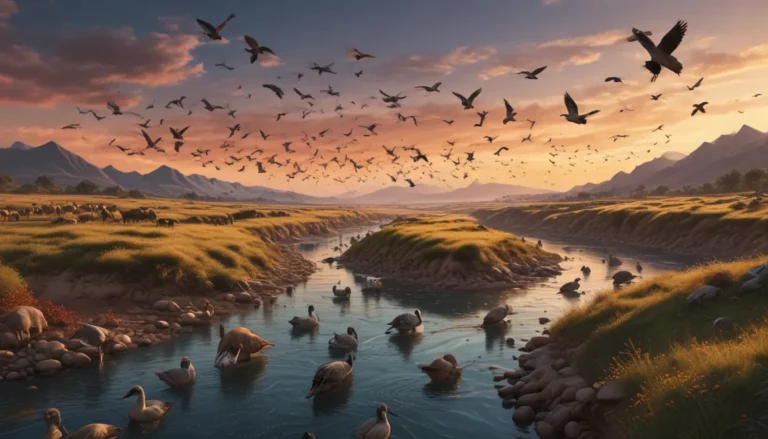A Note About Images: The images used in our articles are for illustration purposes only and may not exactly match the content. They are meant to engage readers, but the text should be relied upon for accurate information.
Climate change is a pressing global issue that demands attention and action. With rising temperatures and more frequent extreme weather events, the need for adaptation to these changing conditions has never been more urgent. Organisms around the world have developed remarkable strategies to survive and thrive in the face of climate change, offering us valuable insights and inspiration on how to adapt to a changing world.
Understanding Climate Change Adaptation
Climate change adaptation involves building resilience through various strategies, such as sustainable agriculture, coastal defense, and renewable energy. The goal is to protect communities and ecosystems from the impacts of a changing climate. Collaboration, gender equality, and education are essential components of effective adaptation, empowering communities to tackle the challenges posed by a warming planet.
The Impact of Rising Temperatures
The increase in global temperatures is a major driving force behind the need for climate change adaptation. As temperatures rise due to human activities, extreme weather events, sea-level rise, and ecosystem changes become more prevalent. Adapting to these changes is crucial to mitigate their impacts.
Building Resilience Through Adaptation Measures
Adaptation strategies aim to enhance the resilience of communities, ecosystems, and infrastructure in the face of climate change. By developing policies and practices that reduce vulnerabilities and increase adaptive capacity, we can better prepare for and respond to changing conditions.
Strategies for Sustainable Agriculture
Agriculture is deeply affected by climate change, making it essential to adapt farming practices for food security. Sustainable agriculture techniques like precision farming, crop diversification, and efficient irrigation methods help farmers mitigate the impacts of a changing climate on their livelihoods.
Protecting Biodiversity for Resilience
Conserving biodiversity is critical for climate change adaptation. Preserving diverse ecosystems ensures their resilience and the survival of numerous species that play essential roles in maintaining ecological balance. Biodiversity conservation is vital for adapting to the impacts of a changing climate.
Coastal Defense Against Rising Sea Levels
Coastal communities face significant threats from rising sea levels and intense storms. Adaptation measures include building sea walls, restoring wetlands, and creating mangrove forests to combat erosion and flooding. Coastal defense strategies are crucial for protecting vulnerable regions from the impacts of climate change.
Urban Planning for Resilient Cities
Effective adaptation to climate change requires careful urban planning to enhance the resilience of cities. Incorporating green infrastructure, flood-resistant buildings, and sustainable transportation systems can help mitigate risks and build more resilient urban areas.
Local and Global Adaptation Strategies
Climate change adaptation efforts can be implemented at both local and global scales. Community-based initiatives and international cooperation are essential for addressing the impacts of climate change and building resilience. Collaborative efforts at all levels are necessary for effective adaptation.
Adaptation in the Insurance Industry
The insurance sector is adapting to climate change by developing products and policies that consider climate-related risks. Providing coverage for extreme weather events and promoting sustainable practices among policyholders are key aspects of the insurance industry’s response to changing climate conditions.
Integrating Indigenous Knowledge
Indigenous communities possess valuable traditional knowledge that can contribute to climate change adaptation. Incorporating indigenous perspectives and practices enhances the effectiveness of adaptation strategies and promotes cultural resilience in the face of environmental challenges.
Crop Breeding for Resilient Agriculture
As climate conditions shift, crop breeding becomes essential to develop new varieties that are resilient to drought, heat, and other climate-related stresses. Investing in crop breeding helps ensure food security in the face of changing environmental conditions.
Addressing Socioeconomic Factors in Adaptation
Climate change adaptation takes into account socioeconomic factors to promote equity and address the needs of vulnerable communities. Supporting low-income populations, improving resource access, and promoting social resilience are key components of effective adaptation strategies.
Investing in Renewable Energy
Transitioning to renewable energy sources is crucial for reducing greenhouse gas emissions and supporting climate change adaptation. Renewable energy infrastructure provides clean energy and enhances community resilience in the face of climate impacts.
The Importance of Collaboration
Effective adaptation strategies require collaboration among governments, businesses, communities, and individuals. By working together, we can enhance resilience, share knowledge, and implement coordinated actions to adapt to climate change effectively.
Water Management for Adaptation
Water management is a priority in climate change adaptation efforts. Conserving water, improving storage, and enhancing efficiency in agriculture, households, and industries are essential measures to address water-related challenges associated with a changing climate.
Considering Health Impacts
The health effects of climate change, such as heat-related illnesses and the spread of diseases, are significant considerations in adaptation strategies. Improving healthcare systems, establishing early warning systems, and promoting public health education are vital components of climate change adaptation.
Ecosystem Restoration for Resilience
Restoring degraded ecosystems is crucial for climate change adaptation. Reforestation, wetland restoration, and marine habitat regeneration enhance the capacity of ecosystems to withstand climate-related impacts, promoting resilience in the face of environmental challenges.
Promoting Sustainable Tourism Practices
Adapting to climate change involves promoting sustainable tourism practices to protect natural and cultural landscapes. Raising awareness about the impacts of tourism, supporting responsible travel, and enhancing local economies are key aspects of climate-resilient tourism.
Gender Equality in Adaptation Strategies
Gender equality is essential for building resilience in the face of climate change. Empowering women in decision-making processes, ensuring equal resource access, and addressing gender-specific vulnerabilities are critical for effective adaptation to a changing climate.
Educating Communities for Resilience
Educating communities and raising awareness about climate change impacts and adaptation strategies is vital for building resilience. Integrating climate change education into school curricula, promoting sustainability, and fostering a culture of resilience are key to effective adaptation efforts.
Economic Opportunities in Adaptation
Adapting to climate change presents opportunities for innovation, job creation, and economic growth. Investing in sustainable technologies and practices can help communities and businesses thrive in a changing climate while contributing to global efforts to mitigate climate change.
Conclusion: Building a Resilient Future
Adapting to climate change is crucial for the survival and well-being of individuals, communities, and ecosystems. By understanding the impacts of climate change and implementing strategies to mitigate its effects, we can ensure a more sustainable and resilient future. Embracing innovative technologies, fostering international cooperation, and empowering local communities are essential steps in building a more resilient world that can face the challenges of climate change.
By working together and taking action to adapt to the impacts of climate change, we can protect our planet for future generations and ensure a more sustainable future for all.
FAQs About Climate Change Adaptation
-
What is climate change adaptation?
Climate change adaptation refers to proactive measures taken to adjust and respond to the impacts of climate change. It involves identifying risks, developing strategies to reduce vulnerabilities, and enhancing resilience. -
Why is adaptation to climate change important?
Adaptation to climate change is crucial for improving the resilience of communities, ecosystems, and economies to the impacts of global warming. It helps reduce damages and losses caused by extreme weather events and sea-level rise. -
How can individuals contribute to climate change adaptation?
Individuals can contribute to climate change adaptation by adopting sustainable lifestyle practices, raising awareness, and supporting renewable energy sources. Small actions can make a big difference in building resilience to climate change. -
What role do governments play in climate change adaptation?
Governments play a critical role in climate change adaptation by formulating policies, regulations, and allocating resources to support adaptation efforts. International cooperation and agreements are also essential for addressing global challenges. -
Can adaptation alone solve the problem of climate change?
Adaptation is essential for reducing vulnerabilities and building resilience, but it cannot solve the problem of climate change alone. Mitigating greenhouse gas emissions and transitioning to a low-carbon economy are also necessary for addressing the root causes of climate change. -
Are there benefits to climate change adaptation?
Yes, there are numerous benefits to climate change adaptation. It can enhance well-being, protect natural resources, promote sustainable growth, and improve resilience to climate-related risks. Investing in adaptation can lead to a more sustainable and resilient future.
Our Commitment to Quality Content
At our site, we are dedicated to delivering trustworthy and engaging content that is both fascinating and credible. Each fact on our platform is contributed by real users, ensuring a diverse range of insights and information. Our editors meticulously review each submission to maintain the highest standards of accuracy and reliability, guaranteeing that the facts we share are credible and informative. Explore and learn with us, trusting in our commitment to quality and authenticity.






